The moments that matter
Read the research
People continue to want flexibility at work—our research shows that nearly half (48%) of global employees are likely to ask their direct manager for a more flexible work schedule or location in the next year.1 But maintaining connection in flexible work takes work. Organizations that don’t actively bring people together for moments that matter put connection at risk: 43% of employees feel disconnected from their company.1 The tension between flexibility and connection at work isn’t new and therefore requires an innovative solution. AI innovation is already improving how you work; improving where you work is the next opportunity. With Microsoft Places, an app that reimagines flexible work, AI can make coordinating in-office time and connecting with coworkers even easier.

Microsoft Places
Join the Public Preview program for the new connected workplace app that reimagines flexible work.
In addition to fostering improved coordination and connection, Places optimizes the effectiveness and engagement of the workplace. Importantly, Places features are accessible across surfaces you regularly use for coordination and collaboration, like Outlook and Microsoft Teams, so flexible work coordination and connection can happen within your normal flow of work.
Coordinate when and where you come into the office
Scheduling in-office time with coworkers and planning ahead to book rooms and a desk are regularly cited challenges for flexible teams. When employees get to the office, they don’t want to be greeted by a sea of empty desks—they want facetime with their manager and the coworkers they collaborate with most frequently. Nearly half (49%) of global knowledge workers have struggled with this situation over the past year.1
With Places, you can more easily coordinate across coworkers and spaces in the office. Places location plan allows you to set and share your proposed location schedule with coworkers while also viewing their plans.

Updating or adjusting your location is always available within the Places app, but it’s also accessible within your regular flow of work in the Outlook Calendar. With a click, you can adjust your schedule and access the peek card—which shows your closest collaborators who plan to come in and allows quick access to space booking—for more information. There is also a link on the peek card that allows you to see all coworkers schedules in the Places app.

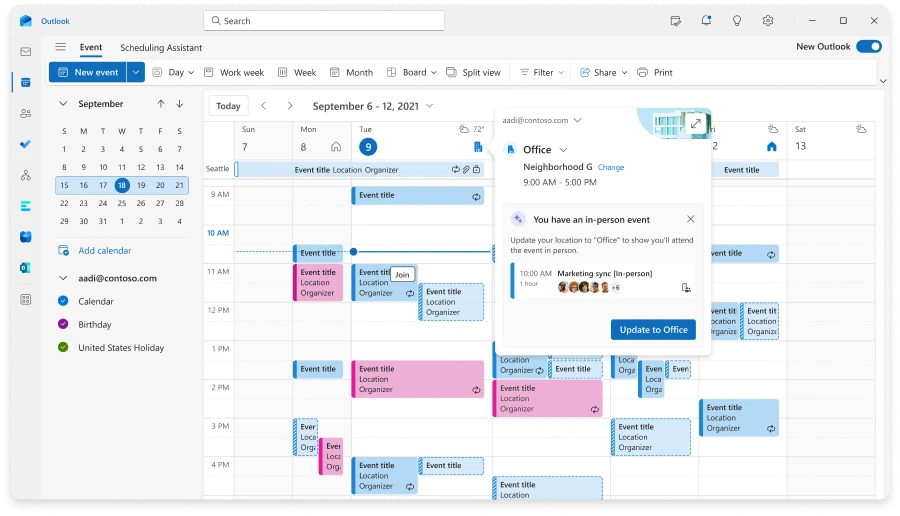

In addition to coordinating schedules with coworkers, you can easily see your manager’s schedule expectations too. With team guidance in Places, managers communicate which days their team should plan to be in the office and what the priorities are for each in-office day. Providing a purpose for team days in the office gives you another reason to come into the office.



The integration of Places data into Microsoft Copilot will make coordination even easier. Coming in the second half of 2024, you will be able to use Copilot to understand which days are best to come into the office. Copilot will even share reasons why certain days are best to come in, highlighting things like in-person meetings, your manager’s planned attendance, or if most of your coworkers are planning to be in the office. You will be able to ask Copilot to adjust your schedule based on this information—changing your work location to the office on recommended days and rescheduling in-person meetings.



After you’ve decided which days to come in, you’ll need to find the right spaces for your meetings and focused work. From software to hardware, Microsoft offers an end-to-end booking solution that provides an improved workplace experience. Starting with the Places finder, accessible in Outlook, you can now search for rooms and desks and receive additional information to guide your booking decision. Places finder shows images of the room or desk pool, includes a map of where the space is in the office, and offers details about available technology or other amenities. Places finder can be enhanced when combined with other workplace experiences from Microsoft and our device partners. With Teams, users can take advantage of bookable desk capabilities that allow users to walk up to a shared work desk, connect their laptop to the monitor, and reserve the spot automatically.



In your Calendar, Places also provides helpful reminders if no rooms or desks have been booked for an in-office day. You can click on the location pin in Calendar to bring up the peek card and browse suggestions for desks and rooms that best meet your needs for the day.



End-to-end booking will be further enhanced with Copilot in the second half of 2024. Building on booking suggestions Copilot managed booking will find and book the right space for the needs of your meeting for recurring meetings where one room might not be available week-to-week.

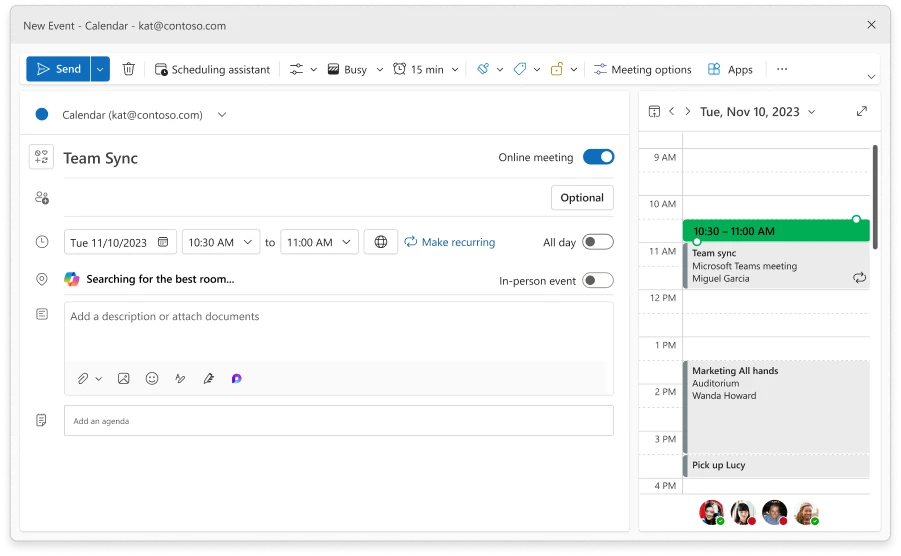

Enable more in-office connections
One of the perks of being in the office is an impromptu conversation with coworkers. With expanded presence, a new Places feature that appears across Microsoft 365 apps, you can see coworkers who are nearby. With awareness of who is around, quick chats can happen in-person or an overdue lunch can be scheduled. By adjusting presence to indicate when an employee is in the office or which building they’re in, coworkers easily see when they’re nearby.


In Teams group chats, coworkers can see participant locations or type @nearby to notify those around them about an activity or change in the meeting room.



It’s important to note that in making sure flexible work ‘works,’, all location data collection adheres to Microsoft stringent privacy standards. Opt-in and opt-out controls for expanded presence are available at both the tenant admin and user levels, are limited to signals about in-office locations, and will be aggregated and anonymized in reports about office occupation trends.
Confidently optimize the effectiveness of the workplace
IT Admins and Real Estate and Facilities (RE&F) professionals have encountered challenges in flexible work too. Static buildings haven’t kept pace with the evolving nature of how and where employees work. AI can play a role in improving the management of space by actively highlighting areas of opportunity for optimization.
Any decision about optimizing the workplace must start with an understanding of what spaces are available and how they are being used. Combining intent and actual occupancy patterns available in Places allows administrators to see a clearer picture of the space available and what’s actually needed.

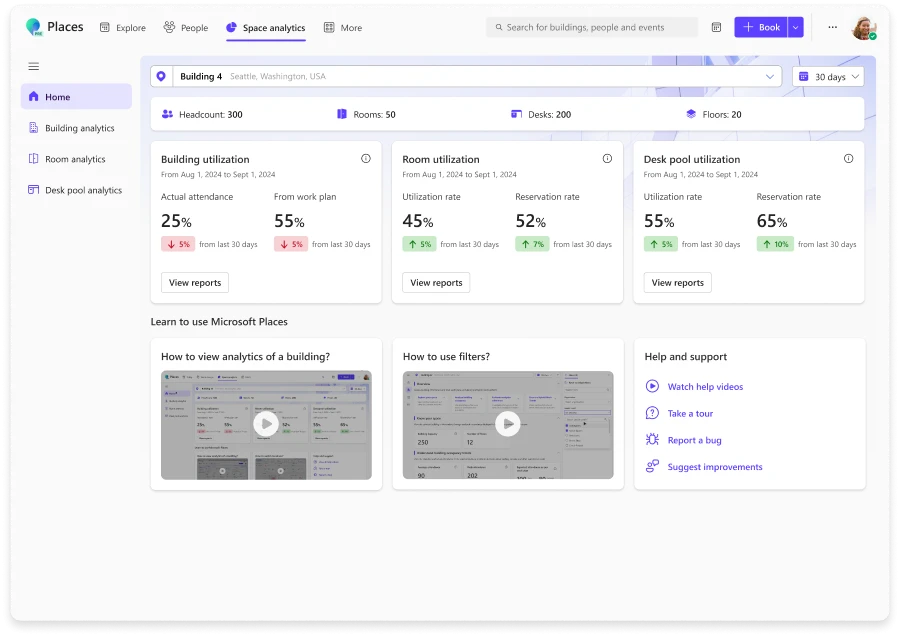

Unlocking the power of collaboration
Read the e-book
Utilization of spaces is another important input in managing the workplace. With more integrated check-in functionality for conference rooms and desk pools, administrators can adjust policies to automatically release unused rooms or desks that have been booked—creating clarity on actual utilization of bookable spaces. Microsoft delivers utilization insights and analytics across workplace products. In addition to device deployment and management capabilities, Microsoft Teams Rooms Pro Management provides valuable space and device utilization data for meeting and collaboration spaces and shared desks that can help validate intent data in Places.

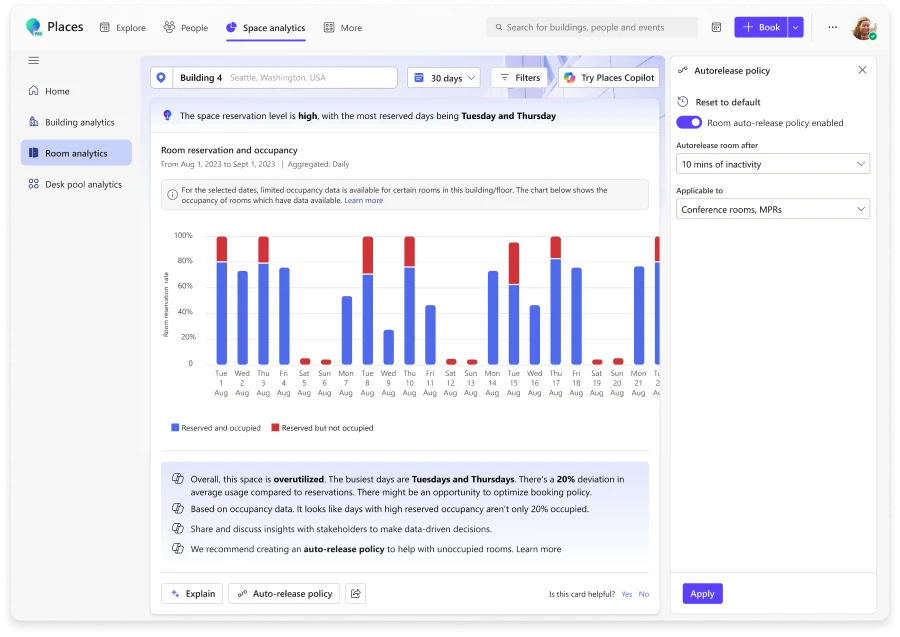

Coming in the second half of 2024, the data from Places will enable Copilot to provide additional intelligence to guide IT admins and RE&F professionals on how to manage and adapt space, like suggestions about consolidating floors on days with low occupancy, adjusting food services to avoid waste, or adding more huddle rooms to support new ways of working. Administrators will be able to run additional analysis on the connected workplace data they’ve collected to make even more informed decisions or better understand patterns and trends that exist. Adjustments can have a material impact on an organization’s operating budget and sustainability goals.

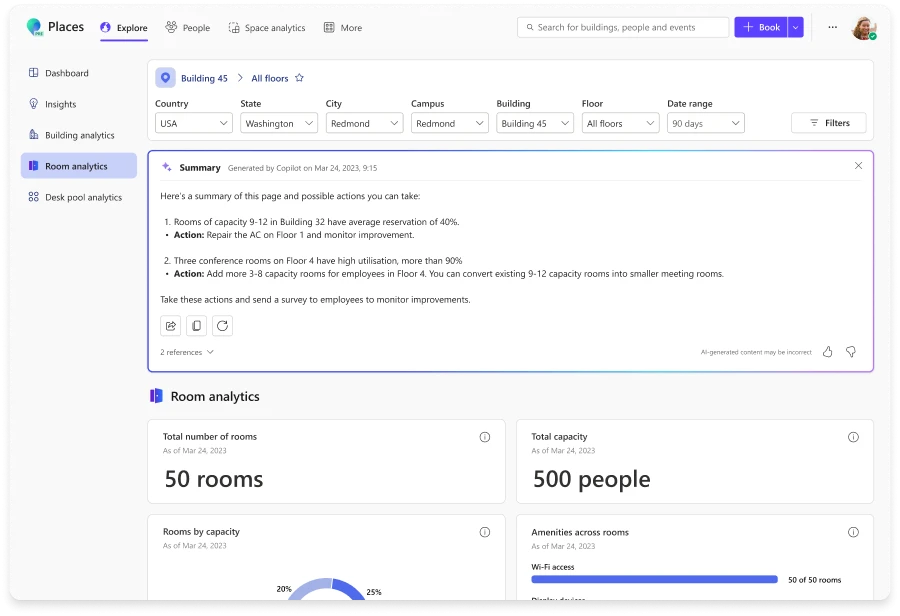

Get started today
As we continue to build solutions across the connected workplace, we’re actively partnering withcompanies across this market. With Microsoft Places,we are starting with a subset of ecosystem of partners (listed below) who will build on top of the Places platform with new and existing solutions, leveraging and enhancing data related to people, location, and space. As Places capabilities grow and expand, so will the partner ecosystem.

Places will be licensed as part of Microsoft Teams Premium, contributing to the Teams vision to build a smart workplace. Get started today with Places coordination and connection features and sign up for access to additional features. Copilot integrations will be available in the second half of 2024—improving where you work.
For the latest research insights on the future of work and generative AI, visit WorkLab.
1May2024 Work Trend Index survey, Microsoft.